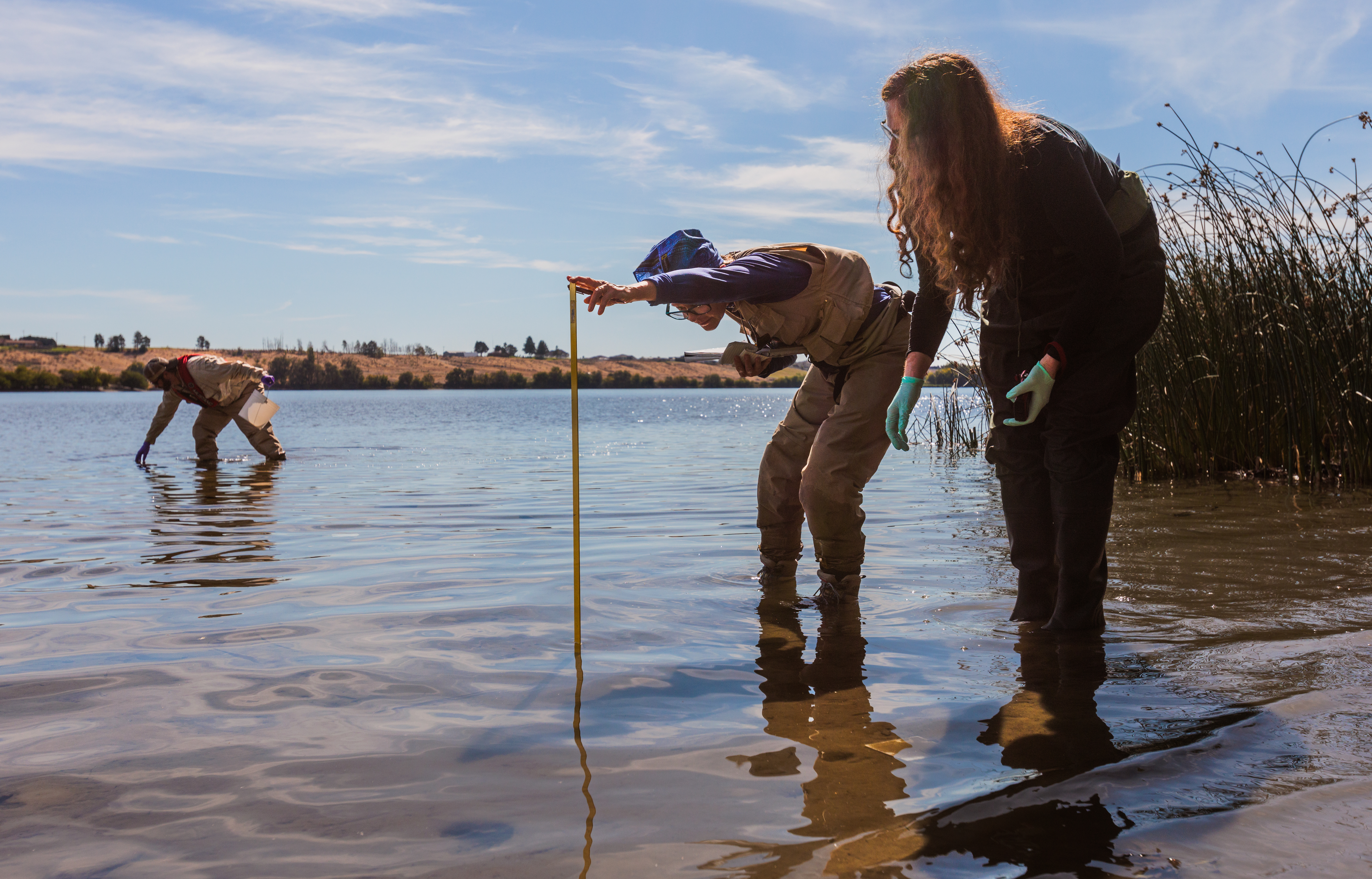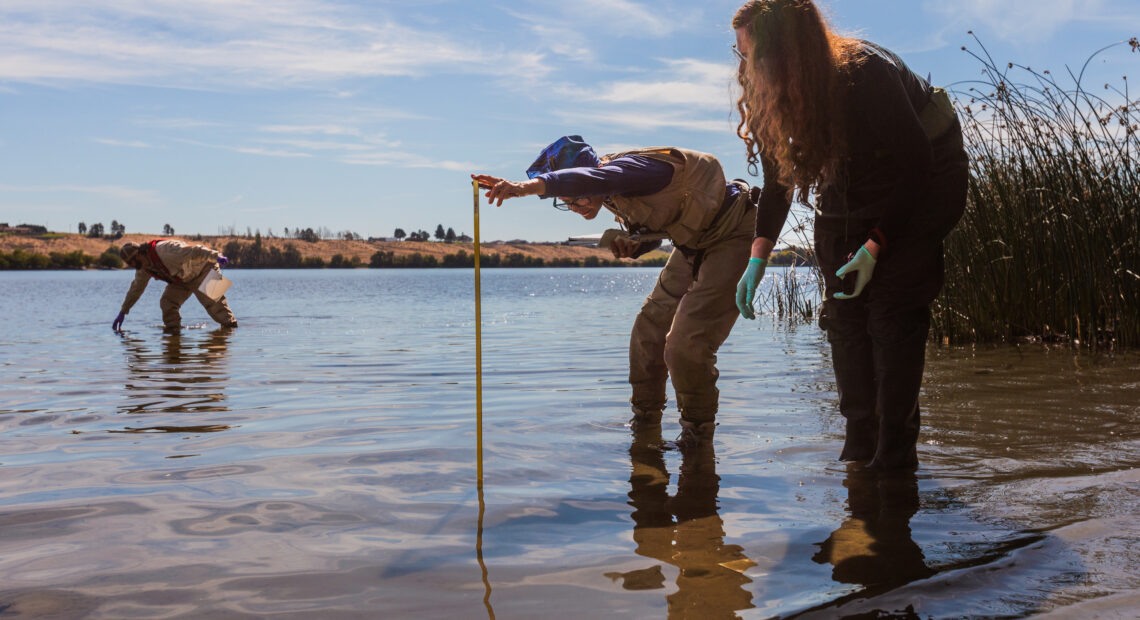
Big trouble on the Columbia: EPA studies river’s toxic algae spread
Listen
(Runtime 4:02)
Read
It’s still warm in the afternoon on the edge of the Columbia River as water laps against the shore.
A team of Environmental Protection Agency scientists are splashing around in wader suits. Some wear elbow-length gloves. They are studying something sinister – toxic algae. It lurks near the bottom of lakes, streams and even big rivers.
“Do you think we got everything?” asked Lil Herger, with the EPA.
“I have the pitcher. We’re going to blend up here though right?” responded EPA scientist Rochelle Labiosa.
Toxic blooms of blue-green algae (cyanobacteria) are developing in many American lakes, rivers and streams. The toxins can poison dogs and cattle – and sicken people. Now, the EPA is working to develop better tools and methods to sample hard-to-track toxins — and they’re starting their work on the Columbia River in Richland.
Recently, the Benton-Franklin Health District said at least two dogs died after being at the Columbia River.
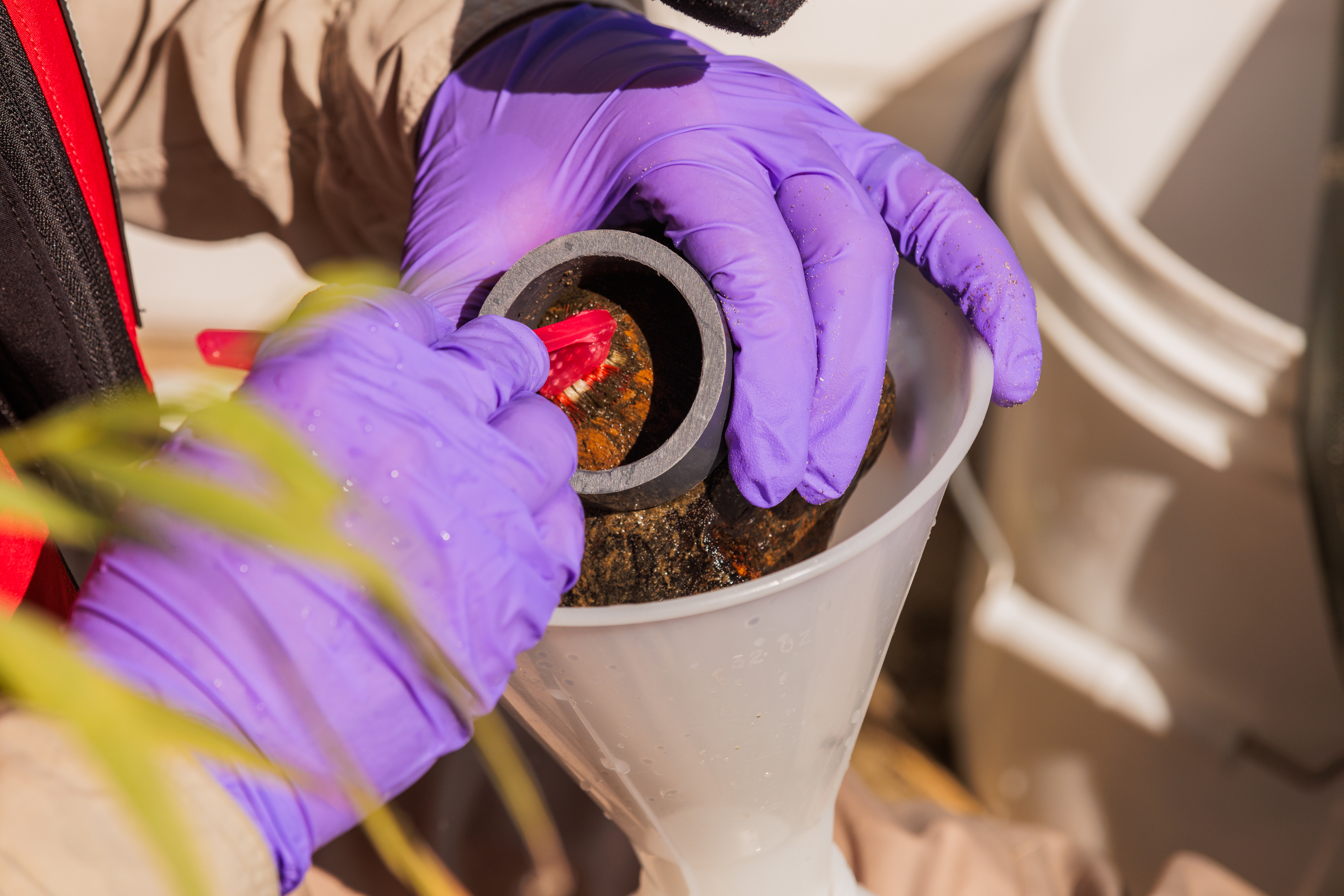
EPA scientist Jason Pappani scrapes a measured area inside a loop with a toothbrush and then rinses the loose algae into a container for analysis back at a lab. (Credit: Rajah Bose)
Down to the river
“Now we’re going down to the Reach and we’re going to sub-sample each transect that was labeled with a little flag,” Labiosa said, leading the way down to the river, which was echoing with wild geese and power boats.
She was in eastern Washington, leading an EPA team grappling with how toxic algae is increasing on river bottoms — creating toxins that flow downstream; toxins that sometimes eddy and kill.
“The benthic harmful cyanobacteria are an emerging issue across the nation, it started coming up more and more.” Labiosa said. “So, when we have a complicated issue like this, that’s when we conduct these research projects.”
Across the nation
Toxic algae was found this summer in major rivers like the Columbia near Richland, the Snake River and in Oregon’s Willamette in Portland. Some of Labiosa’s EPA colleagues are tracking toxic algae across the nation: at Escalante National Monument in Utah, the Shenandoah River in Virginia and the American River in California.
At the Columbia’s edge, the scientists carried white tiles and a long, rolled-up tape measure. The team created a grid, dropping the tiles about every six feet.
“Then, we’re going to take a view of each point with a bathyscope and see how much cover there is,” Labiosa said. “See how much algae there is adhering to the rocks or to the bottom.”
A bathyscope is a sort of awkward, hand-held periscope to see to the bottom of the river.
The EPA is sorting out which method can best predict toxic algae growing on the bottom. With a warming climate, even more potentially-deadly algae is expected.
“Our goal is to really compare these methods and see if they hold for different types of stream reaches and see what might be an optimal set of methods to apply,” Labiosa said.
In a nearby park picnic shed, Jason Pappani, another EPA scientist, had his head bent down, intensely focusing.
“Normally I’d be making a lot of cuss words right now,” Pappani said, awkwardly juggling a rock in hand, along with a ring and toothbrush. “So this is just scraping the algae off the rock. We’ve got a known area with this plastic ring. It’s just a toothbrush. Then just rinsing it into the bottle with some river water.”
After collection, the samples in vials are flown in big coolers to Cincinnati, Ohio, and other EPA labs across the country, for testing.
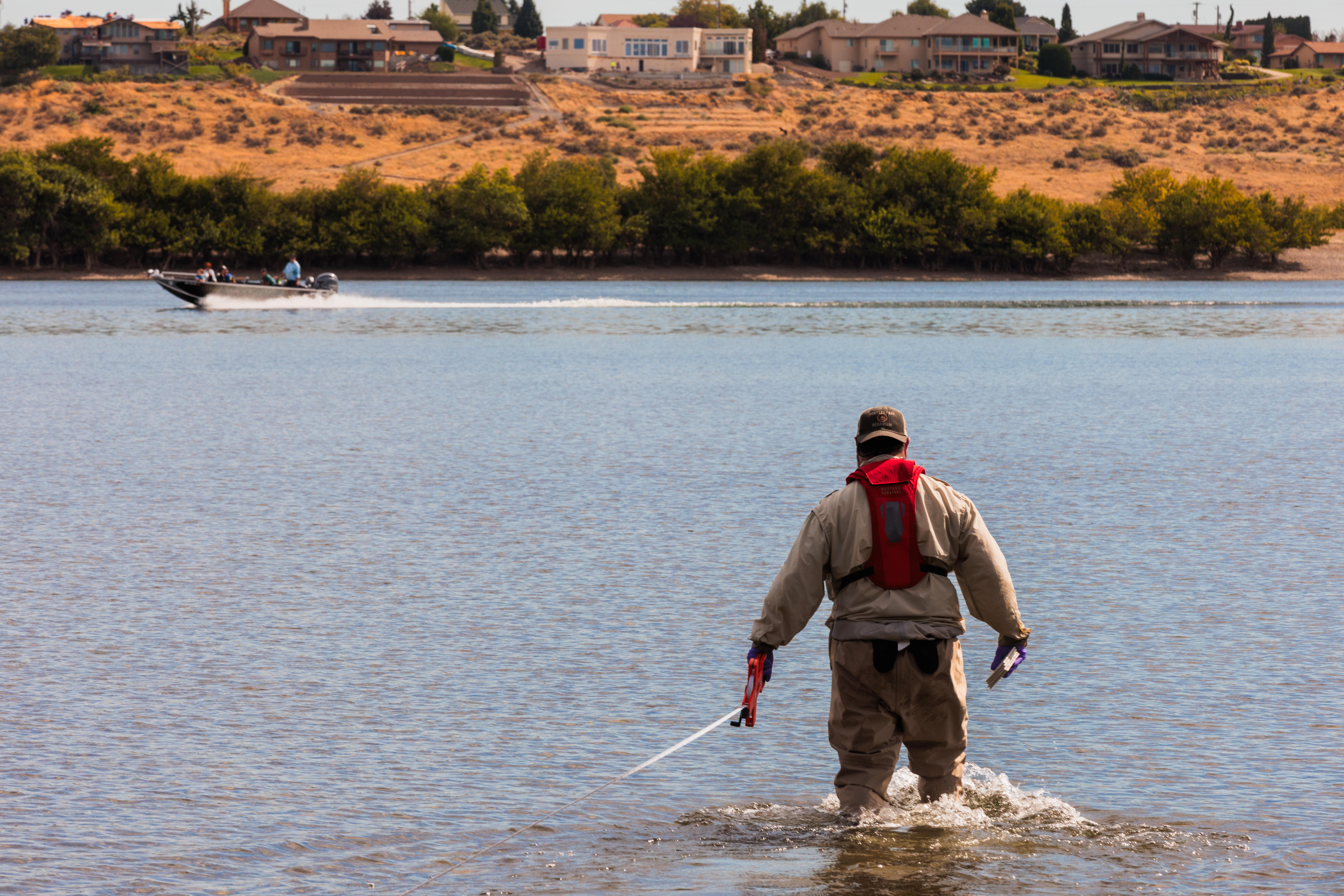
Jason Pappani stretches a tape measure out into the Columbia River at Leslie Groves Park to grid the shoreline and shallow river for scientific algae measurements. (Credit: Rajah Bose)
Roll on Columbia in trouble?
Two other federal agencies, the U.S. Army Corps of Engineers and U.S. Geological Survey, are also getting more intense about studying the Columbia River.
The Army Corps has launched a study above Chief Joseph Dam, at Rufus Woods Lake on the river.
The Corps took samples bi-weekly from June through September to study cyanobacteria and cyanotoxins, the toxins made by algae.
So far, the Corps has determined the toxic algae is benthic, or bottom dwelling. It’s regularly producing anatoxin-a in quantities that exceed state guidelines.
“Rufus Woods Lake has experienced recurring harmful algal blooms since 2010,” the Corps said in an email statement. “[Rufus Woods Lake] is one of three lakes in Washington state known to have recurring concentrations of the cyanotoxin, anatoxin-a, that historically exceed the state guideline of 1 µg/l [microgram per liter.]”
The USGS is monitoring a probe about 5 miles north of Richland, in Franklin County. The probe can measure water turbidity, pH, temperature, algae biomass, chlorophyll, conductivity and even light absorption to detect the cyanobacteria pigment phycocyanin … all in real time.
The river probe is 30 pounds and looks like a heavy chuck of pipe. It sends data straight up to a satellite and relays it to the web.
The goal is to ultimately develop predictive tools to alert cities and counties when highly toxic algae events may be coming. And to develop a history of water chemical and physical parameters that indicate when high algal levels are present.
The USGS is helping locals look at harmful algae blooms across the country, using some federal matching funds with local agencies.
“So far, local habitats and weed beds around my sensor are really disproportionately important,” said Patrick Moran, a USGS biologist based in Tacoma. “We’re trying to sort out to what degree it’s measuring the weed bed right next to the sensor and to what degree it’s sensing the entire river. That’s really what we are wrestling with right now.”
The USGS is trying to install a second probe — near the confluence of the Columbia and Yakima rivers, downstream of Richland.
USGS is also trying to figure out the algae problem from a distance.
“A couple people in our office are downloading satellite imagery, to see if we can see from satellites early detections of growth,” Moran said.
Still, with all these federal and regional studies on the Columbia River, Jim Coleman, with the Benton-Franklin Health District, says it’s been difficult to coordinate all the findings and make recommendations.
“A lot of us are working on this,” he says. “Everyone has a little bit of the data.”
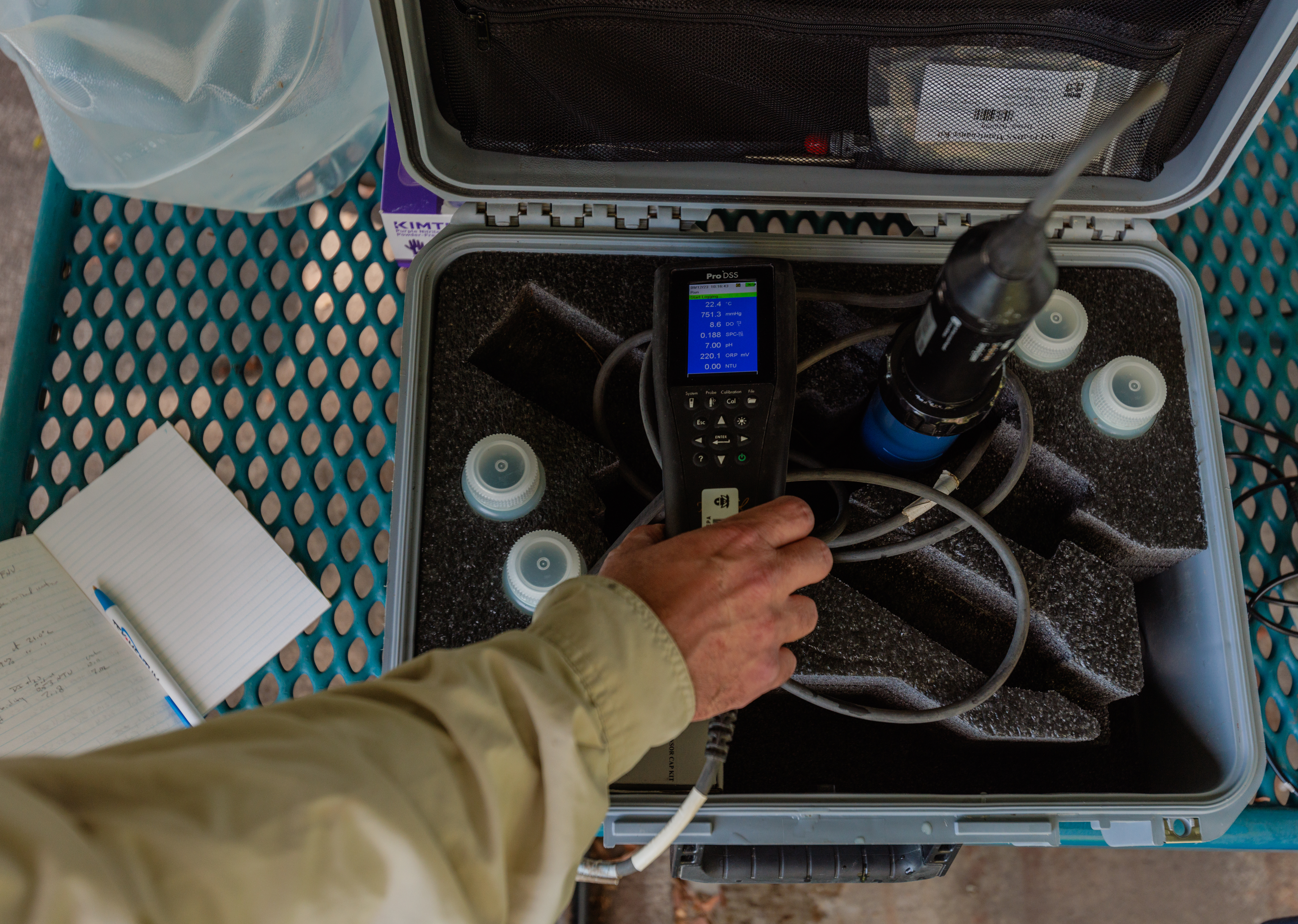
A sonde measures water properties like the concentration of dissolved oxygen, temperature and salinity near the Columbia River in Richland. (Credit: Rajah Bose)
Where it lurks, and the signs
With the warm, fall weather, many are still using and swimming in the Columbia River in the Tri-Cities, despite posted signs and warnings about the toxic algae that can kill animals and sicken people. Benton-Franklin Health District in the Tri-Cities is asking people to take precautions, ideally keeping children and pets out of the river water.
Areas of concern this summer have included: Howard Amon Park’s swim beach, Wade Park, Leslie Groves Park and Columbia Point Marina Park. Now, restrictions are just on Howard Amon Park. Of increased concern is swimming and fishing docks in the Columbia, said Coleman.
“There are various locations where the river current, and Howard Amon Park is a prime example of it, there’s a huge eddy out in the river,” Coleman said. “And whatever is floating in the river gets sucked into the shoreline. The current flows kind of upstream, and if there is a dock or another structure protruding out into the water, then a lot of the solids that are floating on the surface will accumulate at these docks.”
That, he says, is hazardous because those solids and the water near them have tested higher in toxin levels consistently in the lab this year. Especially if the solids are lapped up by dogs, or played with by children, it could cause sickness or death, Coleman said.
Animals that are exposed to toxic algae may experience weakness, staggering, difficulty breathing and convulsions. In people, signs could include numbness of the lips, tingling in the fingers and toes and dizziness.
Toxic algae can be found at high levels even during the winter. So, Labiosa said, when in doubt – stay out.

